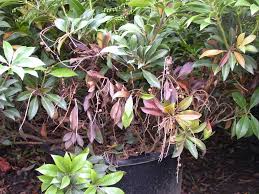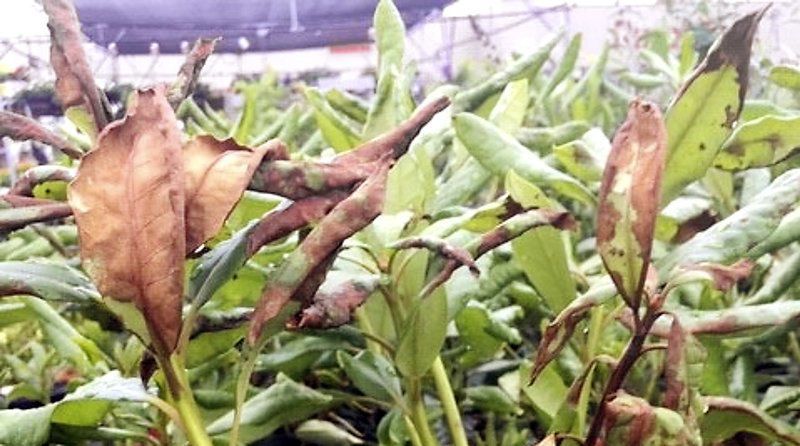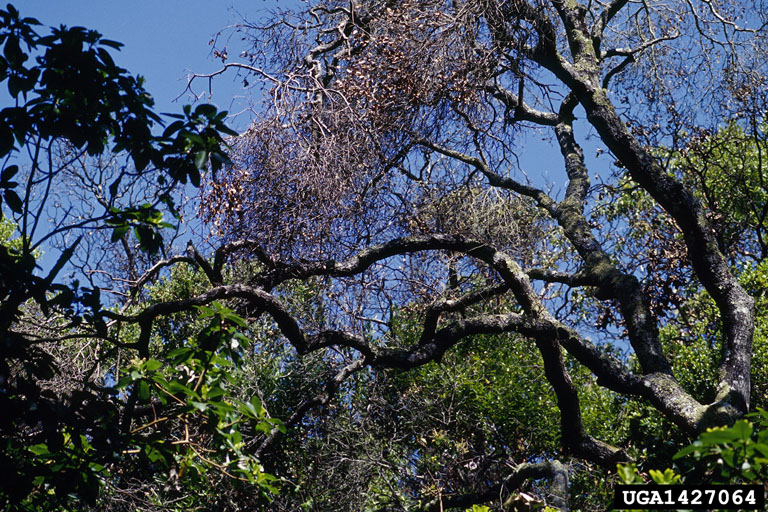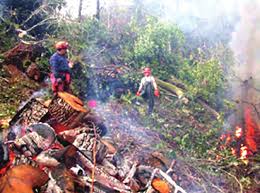SOD in the nurseries

photo by Jennifer Parke
Oregon State University
As you may remember, in May 2019, we became aware of a troubling outbreak of the sudden oak death pathogen Phytophtora ramorum in the nursery trade. The discovery was made by Indiana authorities, who carefully inspected plants being sold in the state.
Briefly, 28 states initially learned that they might have received plants from the suspect sources. Later, APHIS determined that plants exposed to the pathogen had been sent to 18 states – Alabama, Arkansas, Iowa, Illinois, Indiana, Kansas, Kentucky, Michigan, Missouri, Nebraska, North Carolina, Ohio, Oklahoma, Pennsylvania, Tennessee, Texas, Virginia, and West Virginia. Of these, seven (Iowa, Illinois. Indiana, Kansas, Missouri, Nebraska, Oklahoma) plus Washington were known to have received P. ramorum-positive nursery stock. [California Oak Mortality Task Force Newsletter August 2019]
The 2019 episode was just the latest of several occasions since 2004 in which infected plants have been widely distributed by the nursery trade, despite federal and state regulations.
APHIS delays in explaining the situation and what actions it was taking led the states to complain through a letter from the National Plant Board.
For discussions of the 2019 espisode, see my earlier blog or the California Oak Mortality Task Force newsletter for February 2020.
What have we learned from this episode?
1) Three West coast states – California, Oregon, and Washington – are a usual source for the nursery trade of plant taxa that happen to host the P. ramorum pathogen plants. These states’ climates are conducive to growth of these plants and of the pathogen. After repeated nursery outbreaks over 16 years, I think it is time to question continued reliance on such a high-risk source for these plants.
2) APHIS funds the federally-mandated inspection programs in the three states through the “specialty crops” line of the agency’s annual appropriations. Funding levels have apparently remained steady in recent years (COMTF Feb 2020), despite increases in the overall funding for the “specialty crops” line in recent years. I – and some of you! – have lobbied for these increases precisely in order to address the P. ramorum threat. Why has the funding not been increased?
3) While APHIS allocated $352,945 (COMTF February 2020) from the Plant Pest and Disease Management and Disaster Prevention program to help states carry out nursery surveys in 14 states following the 2019 incident, some of the affected states were not included in the program and some states that had not received suspect plants were. States that did not get funding in Fiscal Year 2020 (2020 award report) included three where P. ramorum-positive plants were detected: Iowa, Illinois, and Indiana; and one state that had a scare – Pennsylvania received plants but none tested positive. Seven states received P. ramorum survey funds through the Plant Pest and Disease Management and Disaster Prevention program although they had not received positive plants in the 2019 incident. These were Maryland, Massachusetts, Nevada, New York, North Dakota, Rhode Island, and South Carolina.
The Plant Pest and Disease Management and Disaster Prevention program distributes $70 million annually, and is not subject to annual appropriations. Does a national crisis play any role in determining which projects get funded? Or are decisions made entirely on a proposal by proposal basis and so depend on states’ priorities and individuals’ grant-writing skills?
4) Even now, on the verge of a new plant shipping season (if one occurs given the Covid-19 virus shutdowns), I have seen no public information clarifying how the inspection systems in Washington, British Columbia, and at the U.S. border failed to detect the infested plants before they were shipped. Trace-back efforts carried out by state and U.S. authorities pointed to a nursery in British Columbia as the original source of the infested plants. However, the Canadian Food Inspection Service (CFIA) determined that no Canadian nursery shipped infected plants to the U.S. in 2018 or 2019. See the next paragraph for a description of APHIS’ efforts to resolve this discrepancy.
According to information in the Oregon Department of Agriculture report for 2019, plant imports from Canada are inspected by DHS Customs and Border Protection (CBP) agriculture specialists, not by APHIS. Apparently, CBP has been relying on rules applicable to fruits and vegetables (Q-56) rather than the more stringent provisions of the plants for planting regulation (Q-37). Alerted by Oregon to the importation of 15 Euonymus plants infested by a federally-designated quarantine pest (a thrips), the National Plant Board sent a letter to APHIS in August 2019 asking that it correct CBP’s inspection process.
In March 2020, APHIS sent a letter to the states saying it had amended its Manual and guidance to CBP agricultural inspectors to clarify that all plants for planting must be handled in accordance with the more stringent Q-37 regulations. Furthermore, APHIS is working with CFIA to clarify understanding of each other’s P. ramorum procedures. The letter states that APHIS might consider prohibiting importation of P. ramorum hosts from Canada until CFIA demonstrates that it has adopted effective management measures.
This action by APHIS demonstrates a new seriousness in addressing P. ramorum. I hope this gravitas will persist and carry through to 1) strengthening theregulatory conditions governing domestic production and sales see following section); 2) providing financial and other support to the states (see above about the “specialty crops” appropriation); 3) funding additional studies to clarify the host list and modes of transmission; and 4) using its authority under NAPPRA to curtail imports of plants from Vietnam and other areas where there are large numbers of newly detected Phytophthora species that might threaten North American plant species.

I question sufficiency of inspection and mitigation regime
(as described in the February 2020 COMTF newsletter)
When alerted to the infected plants turning up in Indiana, in May 2019, Washington State Department of Agriculture (WSDA) began trace-back investigations. The large wholesale shipping nursery that supplied the plants appears to have acted quite responsibly – it destroy 54,000 plants, cooperated in the Critical Control Point assessment, and implemented mitigation actions. However, I am disturbed to read that the destruction of plants in the 10-meter quarantine radius from plants detected to be infected was a voluntary action. Why don’t the regulations require destruction of nearby hosts?
Descriptions of the western states’ inspection systems – those tied to this specific nursery episode and routine inspections under federal and state P. ramorum programs – indicate to me that P. ramorum is circulating in nurseries in the west coast states, but is evading detection. I cite examples from all three states.
One of the positive nurseries in California in 2019 had been found to be positive in previous years and is considered to be in compliance with quarantine regulations. Yet these measures have not been sufficient to ensure that the nursery is pathogen-free now – as illustrated by its testing positive in 2019.
In Oregon, a retail nursery found to have infected plants destroyed all host material located in the block. Is this action sufficient to ensure that the nursery is now pathogen free? What about the soil, water, cull piles, etc.? Oregon trace-back surveys led to various suppliers that had previously not been known to be infested. This leads me to think that the pathogen is circulating below regulators’ attention.
In the wake of the 2019 crisis, Washington State Department of Agriculture (WSSA) inspected “opt-out” nurseries – those that had decided not to join APHIS’ program to ship interstate, but continued to ship within the state. WSDA relied on visual inspection only of host material; the agency collected no samples from plants or nursery soils, water, or plant waste (Feb 2020 COMTF). Given all we know about the difficulty of detecting P. ramorum, I think we need more intense inspections that do sample soils, water, and any nearby plant waste (cull piles).
Meaning of Stream Detections?
The P. ramorum pathogen continues to turn up regularly in water bodies. At a botanical garden in Washington State, plant samples have been negative since February 2016. However, water baits from a small pond were positive in 2019 and previous years. Washington’s Sammamish Riverhas been positive since 2007. In the Southeast, seven streams tested positive in 2019. Most if not all have been positive consistently or at least repeatedly for years. All these positive streams are associated with nurseries previously positive for the pathogen. However, plants in the vicinities of these streams show no symptoms.
The same is true in Vietnam: P. ramorum was found in seven out of eight high-elevation streams sampled, but none of the plants belonging to families that have proved highly vulnerable in North America and Europe had any disease symptoms (Jung et al, 2020. A Survey in Natural Forest Ecosystems of Vietnam Reveals High Diversity of both New and Described Phytophthora Taxa including P. ramorum. Forests, 2020, 11). The Jung et al. 2020 findings are discussed in the COMTF Feb. 2020 newsletter and my recent blog.
SOD in the woods

Joseph O’Brien, USFS
The COMTF February 2020 newsletter summarizes the worrying increase in disease in California woodlands in recent years, which followed the record wet spring of 2017. Aerial surveys documented a big increase in dead tanoak trees and affected acreages in 2018, followed by a smaller increase in 2019 – although still much higher than in 2017. [Details: in 2017, 21,000 dead trees were mapped across 18,000 acres; in 2018, 1.6 million dead trees across 106,000 acres; in 2019, 885,000 dead trees across 92,000 acres.]
California officially records as infested only those counties where infestations have been confirmed by California Department of Food and Agriculture or county Agricultural Commissioners. California currently lists 15 counties as infested. Recent observations by academics or other non-officials of Phytophthora ramorum in Del Norte and San Luis Obispo counties have not yet been confirmed by officials so neither is included in the official quarantine. I understand the need to be certain about reported detections, but we should remember that the disease is probably more widespread than official data indicate.
The newsletter reports Oregon’s treatment efforts – which have totaled 7,300 acres since 2001. I am pleased that Oregon Department of Forestry now has an Environmental Quality Incentives Program (EQIP) project with the USDA Natural Resources Conservation Service and that both the Bureau of Land Management and USDA Forest Service are treating infected areas.

in Oregon
USFS
Still, the quarantine area now covers 31% of Curry County, the EU1 lineage is established in the forest, and ODF and its partners lack sufficient resources to treat all infected areas.
Washington State doesn’t have (known) forest infestations, but it continues to find the pathogen in water bodies; the Sammamish River in King County has been positive since 2007.
In the East, seven states (Alabama, Florida, Georgia, Mississippi, North Carolina, South Carolina, and Texas) participated in the USFS Cooperative Sudden Oak Death Early Detection Stream Survey in 2019. A total of 48 streams were surveyed. P. ramorum was detected from seven streams – five in Alabama, one in Mississippi, and one in North Carolina. All positive streams were associated with nurseries previously positive for the pathogen.
Finally, the newsletter summarizes an article providing advice on managing SOD’s impacts – specifically, conservation of tanoak.
SOURCES
February 2020 issue of the California Oak Mortality Task Force newsletter http://www.suddenoakdeath.org/wp-content/uploads/2020/02/COMTF-Report-February.pdf
Oregon Department of Agriculture Plant Protection and Conservation 2019 annual report
Posted by Faith Campbell
We welcome comments that supplement or correct factual information, suggest new approaches, or promote thoughtful consideration. We post comments that disagree with us — but not those we judge to be not civil or inflammatory.